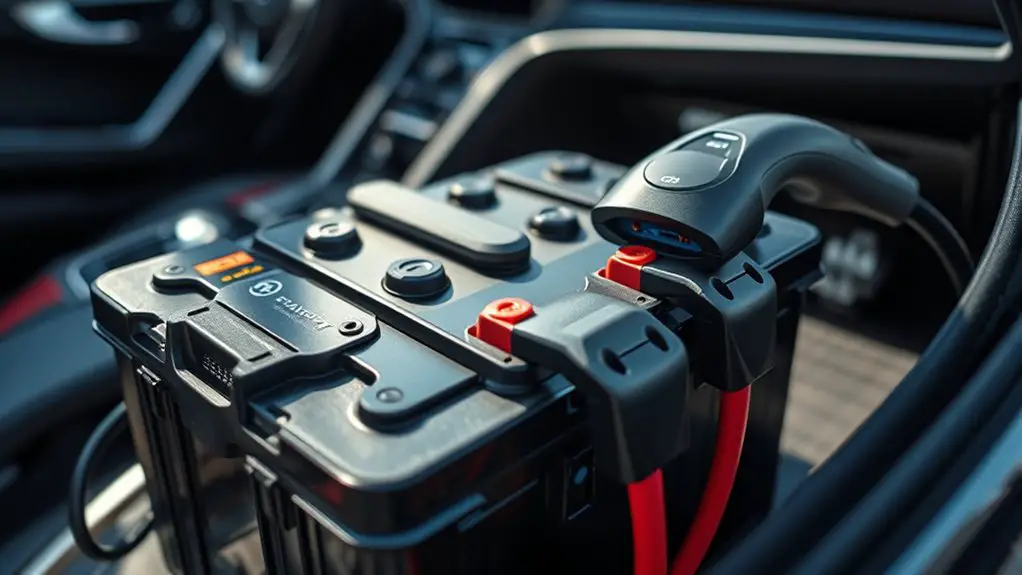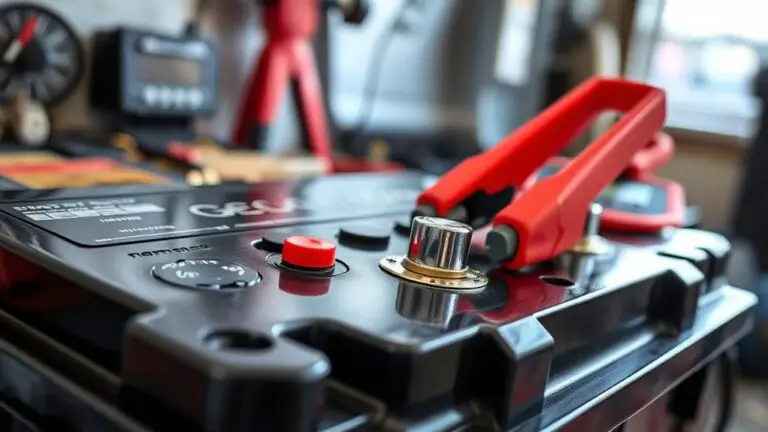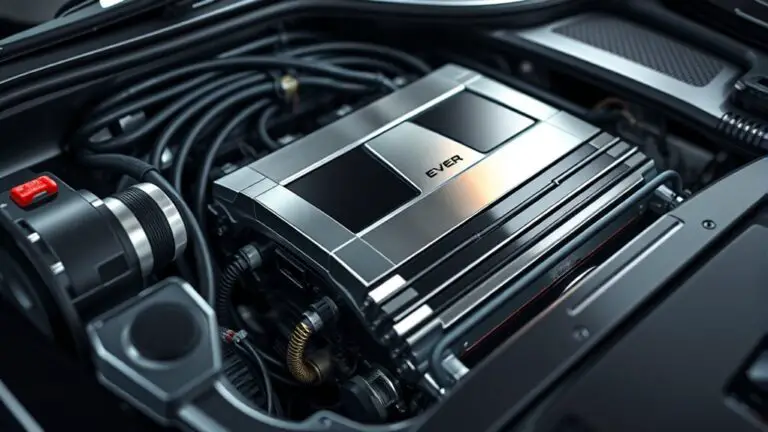Charging Tips to Avoid Aux Battery Drain and Extend Battery Life
To avoid aux battery drain, pair smart chargers with compatible battery types and let them auto-detect charging needs. Minimize parasitic loads by disabling high-draw features when the engine isn’t running, and keep nonessential accessories from staying powered after shutdown. Use fused circuits for critical loads, monitor voltage, current, and temperature, and aim for shallow, temperature-controlled charging cycles. Maintain clean connections and regular firmware checks. If you keep optimizing these habits, you’ll uncover even more efficiency gains.
Smart Charging Habits for Auxiliary Batteries

Smart charging habits for auxiliary batteries minimize drain and extend lifespan. You’ll optimize cycles by pairing a smart charger with compatible battery types, ensuring proper voltage and charging rates. Identify your system’s needs: high or low current draw, temperature range, and float vs. bulk charging. Use a charger that auto-detects battery type and switches modes accordingly, avoiding overcharge or undercharge. For lead-acid variants, keep electrolyte equilibrium in check; for AGM, sealed designs, monitor voltage stability and avoid excessive heat. Lithium battery types demand precise CC-CV profiles and temperature compensation to preserve capacity and cycle life. Establish a charging routine that respects rest periods and avoids continuous high-current exposure after a full charge. Keep cables short and connections clean to minimize resistance losses. Regularly verify charger calibration and inspect terminals for corrosion. Document charging events to track patterns and adjust when you upgrade battery types or expand the system, maintaining reliability and flexibility.
What to Avoid to Prevent Drain on Your Aux Battery

While smart charging habits help maximize runtime, you also need to guard against drain by avoiding common culprits. In daily use, stray parasitic loads—think infotainment, USB hubs, or climate controls—can bleed your aux battery overnight. Prioritize steady power management: disable or restrict high-draw features when the engine isn’t running, and review aftermarket accessories for draw. Avoid leaving accessories powered after shutdown, as even brief wake-ups add up. Be wary of constant high voltage charging; overcharging stresses cells and shortens life, so rely on proper termination and temperature-aware charging strategies. Extreme ambient temps accelerate capacity fade; store and operate within recommended ranges. Ignoring calibration is risky: inaccurate state-of-charge can prompt unnecessary alternator duty cycles. Keep cables tidy and connections clean to prevent resistive losses. Use a dedicated, fused circuit for critical loads, and stagger nonessential draws. By actively filtering parasitics, you elevate reliability and preserve overall power management health for the aux battery.
Monitoring Tools Without the Headache

To monitor your aux battery without the headache, focus on practical, low-noise tools that deliver actionable data without overwhelming you. You want steady visibility, not noise. Choose monitoring apps that run in the background, log history, and alert you only when thresholds matter. Prioritize battery analytics that translate raw numbers into clear trends: voltage, current, state of charge, and temperature over time. Keep interfaces minimal: dashboards with concise charts and bite-sized notes rather than dense spreadsheets. Don’t chase every fluctuation; distinguish normal swings from fault signals. Establish a baseline, then set sensible alerts for high/low voltage, excessive discharge, and unexpected shutdowns. Confirm compatibility with your vehicle or system, and verify data consistency across reboots. Favor solutions that export data for offline review and benchmarking. In practice, use the toolset to confirm drain sources, validate charging behavior, and empower decisions with steady, actionable insights.
Optimizing Charging Times and Temperatures
Timing matters: optimizing charging windows and temps minimizes wear and maximizes efficiency. You’ll maximize life by aligning charge windows with peak availability and minimizing extended high-duty periods. Aim for shallow charging when possible and avoid aggressive top-offs that push voltage or current too hard. Track charging cycles and batch them to reduce frequent full discharges; fewer cycles with partial replenishment are gentler on chemistry. Temperature management is essential: keep ambient and cell temps within recommended ranges, since heat accelerates degradation and cold slows chemistry, both reducing effective capacity. If you use a smart charger, enable charging profiles that taper current as you approach full charge and suspend activity during thermal spikes. When practical, delay charging until temperatures stabilize. Regularly verify that cooling or ventilation isn’t blocked during charging. Document patterns so you can adjust schedules for longevity rather than convenience alone. Your goal: predictable, moderate charging behavior that preserves capacity while meeting needs.
Wiring and Accessory Tips to Reduce Load
Wiring and accessories can quietly dominate load if left unchecked; start by auditing all connections for parasitic draw and eliminating idle circuits. You’ll want a clear map of every circuit feeding the auxiliary battery, with dedicated fuses and isolation where feasible. Use clean wiring techniques: short, direct runs, minimal bends, and shielded lines for ignition-sourced feeds to reduce EMI and stray current. Prefer fused, switched power for accessories that don’t need constant energized status, and relocate high-draw items to a controlled relay or contactor setup. Implement accessory management by grouping devices logically, labeling each branch, and removing redundant circuits. Keep grounds solid and common to minimize voltage drop, inspecting terminal integrity and corrosion. Use weatherproof grommets and proper strain relief to prevent chafing. Document changes and torque specs, verify voltage accuracy under load, and test parasitic draw after re-wiring. This disciplined approach sustains battery life while preserving your freedom to customize.
Practical Maintenance Routine for Longevity
A practical maintenance routine starts with a regular charging schedule to stabilize the battery’s state of charge and minimize stress. Perform periodic battery health checks to catch gradual capacity loss and electrolyte issues before they affect performance. Align your usage habits with these checks by optimizing charging windows and avoiding deep discharges to extend longevity.
Regular Charging Schedule
A regular charging schedule helps preserve battery health by balancing depth of discharge and rate of recharge. You implement a predictable routine that minimizes extreme swings, supporting overall performance. Set a practical charging frequency that suits your usage pattern, avoiding both deep discharges and prolonged high-state charging. Keep cycles evenly spaced to promote battery consistency, which reduces capacity fade over time. Use a smart charger or timer to maintain consistent end-of-charge states and to prevent overnight overcharging. Document your cycle cadence and adjust only when you notice persistent performance shifts, not subtle fluctuations. Maintain steady charging temperatures by avoiding charging in heat or cold extremes. This disciplined approach helps you sustain reliable auxiliary power without unnecessary maintenance interruptions or complexity.
Battery Health Checks
Battery health checks provide a practical bridge from a regular charging schedule to ongoing longevity. You’ll run targeted inspections that translate daily use into objective data. Begin with battery performance metrics: voltage under load, capacity relative to rated, and internal resistance trends. Track health indicators such as cycle count, temperature behavior, and charge/discharge efficiency. Use simple tools—multimeter, hydrometer if applicable, or manufacturer software—to gather consistent readings. Document deviations promptly; small drifts can forecast gradual decline. Cross-verify with benchmarked baselines you established during initial setup. Schedule periodic tests aligned with your usage cadence, not just calendar time. Interpret results for actionable steps—adjust charging parameters, service thresholds, or usage limits. Maintain clean connections, protect against corrosion, and verify firmware updates. This routine keeps you informed, capable, and ready to optimize longevity.
Usage Habits Optimization
To maximize longevity, adopt clear usage patterns that minimize stress on the cell chemistry and thermal load. You’ll optimize battery performance by anchoring routine habits to consistent cycles, avoiding deep discharges, and favoring shallow top-ups when practical. Track your draw, and plan usage to prevent sudden surges that trigger protection modes or thermal throttling. Prioritize energy efficiency: operate at moderate ambient temperatures, minimize unnecessary loads, and disable nonessential peripherals during idle periods. Maintain predictable charging windows, balancing fast charging with cooler operation when possible. Keep battery usage separate from ambient heat sources, and allow gentle cooldown after heavy use. Regularly review sensor alerts and calibrations to sustain accurate state-of-charge readings, ensuring decisions align with real capacity. Effective habits extend life and preserve energy efficiency.
Frequently Asked Questions
Can Auxiliary Batteries Impact Fuel Efficiency or Vehicle Performance?
Aux battery impact on fuel efficiency is usually minimal, but it can affect vehicle performance if the alternator is taxed or the battery is weak. You’ll notice smoother starts and consistent electrical function when the aux battery is healthy. When it’s draining, you might see lowered power for accessories and slight throttle response changes. In short, a healthy aux battery supports stable vehicle performance, while a failing one can indirectly influence fuel economy under load.
Do Solar Panels Ever Overcharge an Auxiliary Battery?
Yes, solar panels can overcharge an auxiliary battery if the system lacks proper regulation, causing solar panel overcharging. You protect against this with a charge controller, temperature compensation, and appropriate battery chemistry. Rely on auxiliary battery protection features like built-in BMS or an external regulator to prevent overvoltage, boil-off, or sulfation. Regular monitoring and correct panel sizing guarantee safe charging, preserving capacity and efficiency while you maintain freedom to roam.
How Accurate Are Voltage-Based Accuracy Gauges for Aux Health?
Voltage-based gauges aren’t perfectly precise for aux health; they’re useful as a trend indicator, not a diagnosis. You’ll see hints from voltage fluctuations, but a healthy battery can ride within a broad range. Rely on impedance or capacity tests for accuracy, and monitor temperature as well. For maintenance, keep terminals clean, balance cells, and avoid deep discharges. Your freedom kicks in when you combine real-time metrics with periodic, structured battery maintenance.
Can Cold Temperatures Permanently Reduce Aux Battery Capacity?
Yes, cold weather effects can permanently reduce aux battery capacity if you expose it to extreme or repeated cold without protection. You’ll see diminished cold-crank performance and slower recovery due to changes in battery chemistry, including sulfation and impedance rise. Protect with insulation, proper charging, and keeping temps above safe thresholds. Short-term cycling hurts less, but sustained freezing alters capacity. Monitor voltage, use warm-up strategies, and consider temperature-aware charging to preserve health.
Is It Safe to Disconnect Aux Battery While Driving Long Trips?
Yes, don’t disconnect the aux battery while driving long trips. You risk system faults or unexpected failures that could affect driving safety. If you must service it, do so with the vehicle parked and power off. Focus on aux battery maintenance and proper charging routines to prevent drain. You want reliable performance, not dramatic surprises. Keep the electrical load balanced, monitor voltage, and follow manufacturer guidelines to preserve driving safety and overall reliability.







